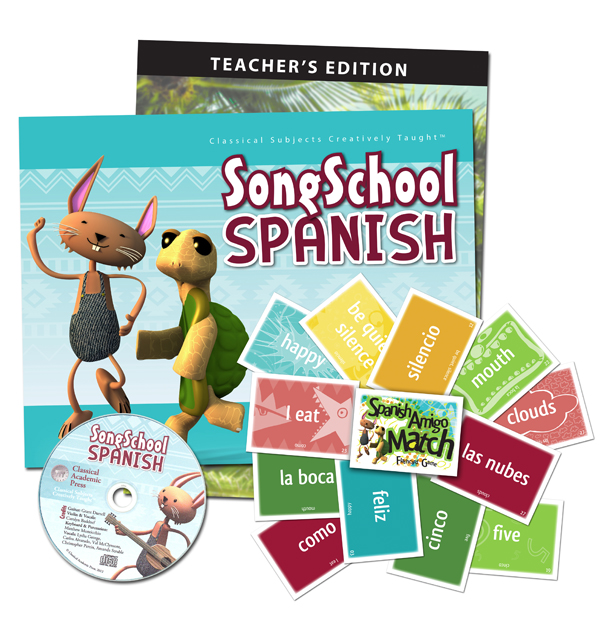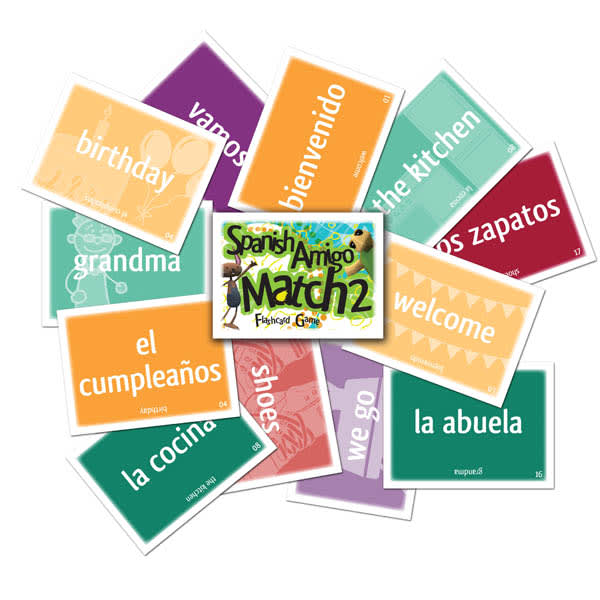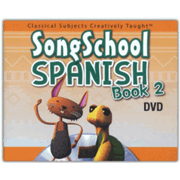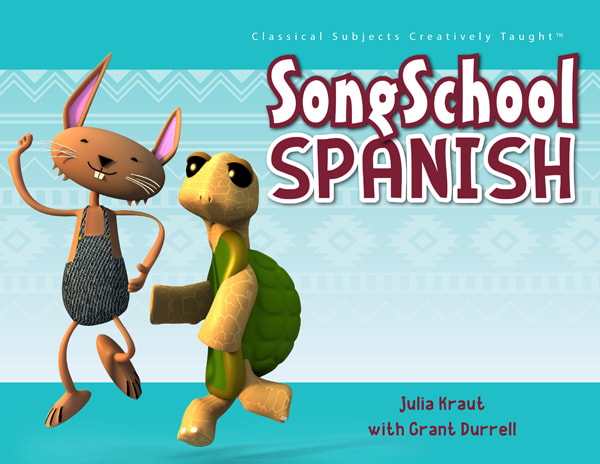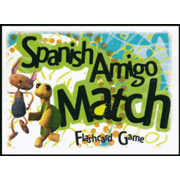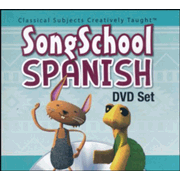Song School Spanish presents a multisensory introduction to Spanish. Book 1 can be used with children in kindergarten through second grade, and Book 2 can be used with children in grades one through three. Each course should take about 31 weeks to complete. You might teach these courses in one lengthy session per week, but ideally, you will break the lessons into shorter segments over three or four days per week.
To provide a multisensory learning experience, Song School Spanish uses video instruction for each lesson, audio CDs with songs and chants, downloadable MP3 pronunciation files and songs, workbook activities, flashcards, interactive games, and an online game. While students can watch videos and listen to CDs on their own, these courses require personal interaction. Parents or teachers should practice vocabulary with children throughout the day, help children sing songs or chants, direct games, and work together with them through the workbook activities. These courses should be easy to teach, even for parents or teachers who don’t already know Spanish.
The teaching approach is conversational, although some points of grammar are explained from time to time. For instance, Book 1 introduces the idea that Spanish verbs will have different endings depending upon who is doing the action, but it is not until lessons in the last half of Book 2 that the course introduces a few verb conjugations.
In addition, Song School Spanish uses what is called “code switching.” Code switching means changing languages mid-speech. For example, it teaches a song, “If You’re Feliz and You Know It, Cuerpo.” Spanish words are substituted in this song that is probably already familiar to many children, with feliz substituted for happy, manos for hands, pies for feet, cabeza for head, and so on.
For each course, the full program set includes a consumable student book with an audio CD, a teacher’s edition, videos (either streamed or on DVDs), and Spanish Amigo Match Flashcards. Purchasers also have free access to downloadable files as well as HeadventureLand.com where students can play a game.
Video instruction goes over the basic content of each lesson which is then repeated and reinforced with other lesson components. The video instruction is presented at a very comfortable pace by what appears to be a mother with her two daughters. The instructor allows time for students viewing the video to respond at different points.
Each video lesson also features a “Little Moments” vignette with people acting out scenes with code-switching language. I think these scenes are really cute. In some vignettes for Book 1, a young girl and her stuffed animals serve as a class responding to commands or participating in activities. Many homeschooled children are likely to relate especially well to these vignettes.
Workbook lessons are presented as chapters, with one chapter to be completed each week. Each chapter, other than the review chapters, has some predictable components. There are vocabulary words or phrases with definitions or translations to be learned. Each course’s audio components—songs, chants, and pronunciation— reinforce vocabulary and pronunciation. During the week, students should frequently practice the songs and chants. Lyrics for the songs are included within the workbook’s lessons. Lessons also have a line or two of tracing activity with Spanish words written with dots on lines. This helps students spell the words properly before they will be required to write them independently.
Workbook activities beyond those I’ve mentioned exhibit a tremendous amount of variety. Students might circle the correct word, match words to images, write Spanish words under images, solve riddles, draw and label a picture, solve a puzzle, or play a game. In Book 2, there are more-challenging activities such as filling in blanks of a code switching story with the correct Spanish word.
The large deck of Spanish Amigo Match Flashcards for each course is to be used for vocabulary review and for games. These cards have words or phrases in a large font in either Spanish or English, and the translation is printed upside down at the bottom of that card in a small font.
If you begin Book 1 with kindergartners, you will probably rely more heavily on verbal interaction and the various media available for the course rather than on the workbook activities that require writing. Reflecting the skill development of children in the primary grades, Book 1 starts out at a gentle pace but gradually becomes more challenging all the way through Book 2. According to the publisher, students who complete Book 2 should be ready for Classical Academic Press’s Spanish for Children Primer A.
The two Song School Spanish courses differ from one another in other ways besides the level of difficulty. Book 1 has several pages of cut-outs at the back of the student’s book that are used with some of the lessons. At the back of the Book 1 Teacher’s Edition, there are one or more reproducible activity pages for each lesson—these are primarily worksheets. The Book 2 Teacher’s Edition includes an appendix with more than 100 reproducible pages for activities that are much more interactive than those in Book 1. There are many more games and activities in Book 2. Most of those games and activities are designed for class groups, but many of them will be useful to homeschoolers.
Instructional information is included on the student workbook pages. The teacher’s editions have reduced images of student pages. While the fonts are smaller in these images, most parents or teachers should be able to teach from them. The images of student pages in the teacher's editions have overprinted answers, and they also frequently have overprinted boxes with additional teaching strategies.
While Song School Spanish requires quite a bit of time from the teacher or parent, the playfulness of this approach is likely to be fun for young students. At the same time, instruction in the fundamentals of Spanish and the gradual introduction of grammar means that children are forming a solid foundation for future language studies.




